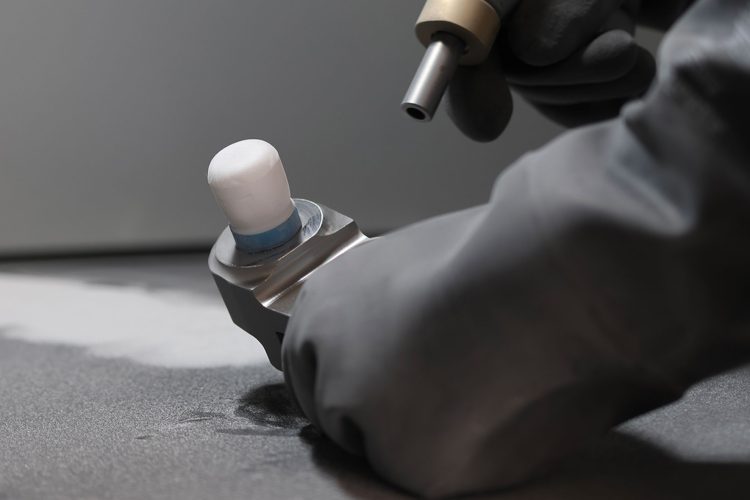Galver Ltd. introduced in 2014 a plant for galvanic treatments for bonding preparation and preparation for painting Of aircraft parts. The plant, which is fully automated and consists of. n. 19 vats plus a drying oven, enables management of production cycles via PLC, with monitoring constant process parameters time and temperature, in full compliance with the Customer’s specifications. With useful tank dimensions 1500x700xh800, the following chemical attack processes can be carried out.


Galver Srl has a steam phase degreasing machine (preliminary stage of each galvanic treatment). The solvent used is perchloroethylene conforming to ASTM D4376, and the useful dimensions of the parts basket are 1500 x 500 x h500.
This treatment removes scale and oxides from aluminum surfaces. It is a treatment used for deoxidizing aluminum surfaces that are to be subsequently bonded or coated with adhesive undercoat (primer). Examples of alloys treated are: 2014 – 2024 – 5056 – 5086 – 6013 – 7050 – 7075 – 7475.
Stainless steels, thanks to the high chromium content in the alloy, spontaneously coat themselves with a layer of chromium oxide, which is very thin, compact, transparent and adheres to the surface: this layer preserves stainless steels from the aggression of the surrounding environment and ensures their resistance to corrosion. However, in order for the passivation mechanism to occur and remain stable over time, it is necessary for the surface state of the steel to be free of any element that could hinder or retard its engagement.
This is the case of weld oxides or oxides due to thermal alterations, contaminants (e.g., particles from other metallic materials), dirt of various kinds (fats, oils, etc…), which may originate from the technological cycle of the processing to which the base material was subjected to arrive at the finished component, or more simply, may depend on poor handling or storage. In order for the stainless steel part to fully guarantee its anti-corrosive properties, its surface must be properly cleaned and prepared to carry out its passivation properties in the best possible way.
The purpose of the sulfuric acid pickling treatment is to remove surface oxides and other contaminants, increasing surface porosity and promoting adhesion. This method can be used on all 300-series stainless steels for structural and nonstructural bonding structural. Examples of alloys that can undergo treatment include 301, 302, 304, 316,321, and 347.
Wet blasting technology in involves the use of water as a component or vehicle to bring the abrasive particles against the surface being treated, thus eliminating the formation of dust that develops during impact.
This treatment consists of directing a mixture of air-abrasive-water onto the surface to be treated: the action of the jet abrasive thoroughly cleans metal surfaces, removing rolling scales, impurities and irregularities that result from primary production processes. In addition to the cleaning action of the metal surface, blasting changes the surface roughness, with an increase in the area of subsequent bonding and thus promotes adhesion.
Galver has a blasting machine with useful cabin dimensions 990 x 990 x h1100. It is possible to process aluminum alloys, copper, nickel, stainless steel 300 series , tungsten.
The dry blasting treatment consists of cleaning the surface by adhesion. A jet of abrasive material is directed onto the surface to be cleaned (aluminum oxide or quartz) under controlled pressure, so as to prepare the same surface for subsequent painting or application of a protective treatment. The dry abrasive jet can be used to prepare 300, 400, A286, PH series stainless steels and carbon steels.
Anodic oxidation treatment is an electrochemical process aimed at creating a stable oxide layer on the surface of aluminum and aluminum alloy parts. The parts to be treated are immersed in an acid solution where, through a direct current flow, the oxygen that develops combines with aluminum atoms to form a controlled-growth oxide layer. The type of electrolyte, in addition to the process conditions, determines the properties of the anode layer, and in particular its porosity. Galver Srl can perform unsealed chromic acid anodic oxidation treatment, and, if required, can also seal the porosity of the oxide layer by appropriate post-treatment In hot water.
Anode coatings are made for one or more of the following purposes:
This treatment is performed on finished parts made of corrosion-resistant steel (CRES) of austenitic, martensitic, and precipitation hardening (PH) grades in order to improve their corrosion resistance. The purpose of the passivation process is to effectively clean and remove from the surface of corrosion-resistant steels the contamination and free ferrous residues resulting from machining or other processes. This process creates a uniform passivated surface condition, improving the corrosion resistance of the material.
The process at present carried out in Galver complies with AMS 2700 Method 1 Type 2 (medium temperature nitric acid passivation with sodium dichromate). The new Reach compliant process conforming to AMS 2700 Method 2 (with citric acid) is being introduced.
This treatment provides improved corrosion resistance and paint adhesion properties to aluminum and its alloys. It can be used on interior surfaces where application of an organic finish is not necessary or feasible, or to repair damaged anode coatings.
Typically, lightweight coatings are used where electrical continuity is required. The product used is Bonderite M-CR 1200S Aero (formerly Alodine 1200S) and the application can be done in two ways:
The pad cadmium plating process allows the deposition of a fine-grained, low-porosity, low hydrogen embrittlement coating with similar adhesion and corrosion resistance as a tank plated coating. It is performed on steel parts for touch-up or repair where the pre-existing plating has been damaged or removed. It can also be used on new parts or assemblies on which the dip process cannot be applied. Pad cadmium plating, when this is used as a local touch-up or repair, must match the type of cadmium plating below, providing for the same type of conversion and thickness.
The benefits associated with this process result: